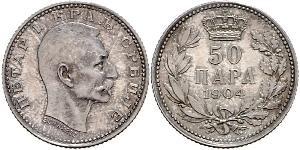20 Dinaro (Vendida por $7.0)
1938, Kingdom of Yugoslavia, Peter II. Beautiful Silver 20 Dinara Coins. AU+
Mint Year: 1938 Reference: KM-23. Denominations: 20 Dinara Condition: Light scratches and contact-marks, otherwise a nicely toned AU+ Material: Silver (.750) Diameter: 27mm Weight: 9.05gm
Obverse: Bare head of King Peter II right / left. Legend (translated): "Kingdom of Serbia / Peter II. King of Serbia"
Reverse: Crown above double headed eagle, value ("20 Dinara / 50 Dinara") below. Date (19-38) split in fields. Legend: 20 DINARA / 1938
Peter II, also known as Peter II Karadordevic (Serbo-Croatian: Petar II Karadordevic; 6 September 1923 – 3 November 1970), was the third and last King of Yugoslavia. He was the eldest son of King Alexander I and Princess Princess Maria of Romania; two of his godparents were King George VI and Queen Elizabeth of the United Kingdom.
His education commenced at the Royal Palace. He then attended Sandroyd School in Wiltshire, England. Then 11 years old, Peter, of the House of Karadordevic, succeeded to the Yugoslav throne in 1934 upon the assassination of his father King Alexander I in Marseille, during a state visit to France. Because of the King's young age, a regency was established, headed by his father's cousin Prince Pavle Karadordevic.
Although King Peter and his advisers were opposed to Nazi Germany, Regent Prince Paul declared that the Kingdom of Yugoslavia would join the Tripartite Pact on 25 March 1941. On 27 March, King Peter, then 17, was proclaimed of age, and participated in a British-supported coup d'état opposing the Tripartite Pact.
Postponing Operation Barbarossa, Germany simultaneously attacked Yugoslavia and Greece. From 6 April Luftwaffe pounded Belgrade for three days and three nights in Operation Punishment. Within a week, Germany, Bulgaria, Hungary and Italy invaded Yugoslavia and the government was forced to surrender on 17 April. Yugoslavia was divided to satisfy Italian, Bulgarian, Hungarian and German demands and puppet Croat, Montenegrin and Serb states proclaimed.
Peter was forced to leave the country with the Yugoslav Government following the Axis invasion; initially the King went with his government to Greece, and Jerusalem, then to the British Mandate of Palestine and Cairo. He went to England in June 1941, where he joined numerous other governments in exile from Nazi-occupied Europe. The King completed his education at Cambridge University and joined the Royal Air Force.
Despite the collapse of the Yugoslav Army, two rival resistance groups to the occupying forces formed. The first were the Partisans, a Communist-led left-wing movement encompassing republican elements in Yugoslav politics, led by Josip Broz Tito. The other were the Chetniks, a predominantly Serbian movement led by royalist General Draža Mihailovic, soon proclaimed the Minister of Defence in the government-in-exile. Starting in November 1941, Mihailovic began attacking the Partisan strongholds, the "liberated territories". The royalist Chetniks soon ceased operations against the occupation altogether, and focused on defeating the Partisans. In this they found a common cause with the enemy and widespread collaboration between the royalists and the Axis troops began, aiming to stamp out the resistance.
Learning of the shift of allegiance from ULTRA intercepts, the Allies switched their support to the Partisans in 1943, as their sources came to indicate an increasing relationship between the Germans and Mihailovic. The Partisans soon gained recognition in Tehran as the Allied Yugoslav forces on the ground. In 1944 the Partisan commander, Marshal Josip Broz Tito was recognized as the Commander-in-Chief of all Yugoslav forces, and was appointed Prime Minister of a joint government.
Peter was deposed by Yugoslavia's Constituent Assembly on 29 November 1945. After the War, he settled in the United States. After many years of suffering from cirrhosis, he died in Denver, Colorado on 3 November 1970 after a failed liver transplant.
He is interred at the St. Sava Monastery Church at Libertyville, Illinois, the only European monarch buried on American soil. His son, Crown Prince Alexander, is the legitimate heir to the Yugoslavian throne.
On 4 March 2007 Crown Prince Alexander announced plans to return the body of his father to Serbia. The plan has upset some Serbian-Americans. Peter II chose St. Sava Serbian Orthodox Monastery as his interim resting place because of the extenuating circumstance that has afflicted his homeland.
Only 1$ for each additional item purchased!

|
Publicado por:
anonymous 2018-10-22 |
|
||
|
||
|
||
|
||
|
||
1/2 Thaler Reino de Hungría (1000-1918) Plata Leopoldo I de ...
grupo tiene 4 monedas / 4 precios
⇑
3 Grosh Polonia Plata Sigismund III
grupo tiene 4 monedas / 4 precios
⇑

-600-300-IXzZC4KO6QcAAAFm1cuYvppg.jpg)

-300-150-IXzZC4KO6QcAAAFm1cuYvppg.jpg)
 Deutsch
Deutsch Русский
Русский Українська
Українська English
English Italiano
Italiano Français
Français Español
Español 汉语
汉语





-300-150-qkIKbzbi_WsAAAFLvFWjltiJ.jpg)








